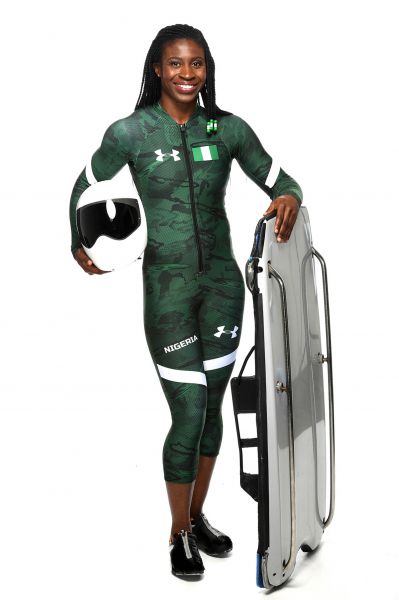Inspired by tennis stars Venus and Serena Williams
The hit song If starts with a simple synthy beat and a percussive melody — it’s classic back-to-his-roots Davido. It is the type of song that makes you want to dance, exploiting the Nigerian pop formula of twisting too-familiar American musical elements through a distinctly local sound and patois.
It’s the song that Simidele Adeagbo plays on repeat, dancing by herself, as she gets ready to launch herself face down on the frozen skeleton racetrack at speeds of sometimes more than 130km/h.
“It just reminds me of the significance of what I’m doing. That this is for the continent and for people back home,” she says.
With just one race to go before qualifying, Adeagbo is likely to become the first woman skeleton athlete from Africa to compete in the Winter Olympics, to be held in South Korea in 2018.
It’s a goal that the 36-year-old didn’t even know she had until six months ago, when she heard of the Nigerian bobsled team — made up of Seun Adigun, Ngozi Onwumere and Akuoma Omeoga — and their Olympic quest.
“Most people don’t match up Africans with winter sports. It sounds like those two things don’t go together at all,” she laughs.
The name Simidele means “accompany me home” in Yoruba, which is significant because a few months after she was born in Canada, she accompanied her parents to Nigeria, where she lived until she was six. But she grew up in rural Kentucky — “the home of Kentucky Fried Chicken” — where she also attended university.
It’s there that she nurtured her strength in track and field, becoming a four-time National Collegiate Athletic Association All-American and triple jump school record-holder.
Adeagbo has now ended a nine-year retirement as a professional athlete to become a Winter Olympian.
She attributes her quick mastering of skeleton racing to her background in track and field: “I was in the triple jump, jumping in sand, and now I’m moving to ice, which seems like two opposite worlds, but there is quite a lot of correlation, actually.”
Skeleton racing is a brutal sport that requires both explosive athleticism and an almost meditative focus. A skeleton racer has to do a “push start” — the first 30m before starting down the track — which means sprinting before jumping on the sled.
“After you jump on to the sled and your face is about an inch from the ice and you are going about 120km/h, it’s really about how do you stay relaxed,” Adeagbo says. “It’s about how you stay focused and remain aware of what your body is doing.”
 Skeleton racing is a difficult sport to prepare for, especially if you live in summery Johannesburg — as Adeagbo now does — and always a continent away from any ice track, of which there are only 18 in the world.
Skeleton racing is a difficult sport to prepare for, especially if you live in summery Johannesburg — as Adeagbo now does — and always a continent away from any ice track, of which there are only 18 in the world.
Away from the ice, she spends two to three hours training in the gym: first on the track — doing sprint workouts in short bursts of 30m to 40m — and then powerlifting and jump training in the weight room.
When she’s in Canada, it’s all about maximising her time on the track. The tracks are between 1km and 1.5km long. “Every track that I go to is different, so you have to figure out how to get down the track as quickly as possible and how to direct the sled in the fastest way possible,” she says.
[Simidele Adeagbo sports her trademark racing gear and beaded braids. (Candice Ward/Supplied)]
For preparation, Adeagbo watches videos of past runs on the track she is about to tackle. She also uses tips and tricks compiled by her peers — which the pros call “track notes” — sometimes fiercely guarded from the competition.
“But ultimately, even if you prepare, sometimes you really, really don’t know what you’re in for until you get there and feel it,” she says.
A skeleton run is largely dependant on the weather conditions — the colder it is, the faster the track will be and the faster she will need to react to avoid injury. During her last competition, she injured her chin.
“Skeleton is a sport that has taught me to be tough,” she says. “I thought I was tough, but this is next-level tough.”
The run is all about feeling, says Adeagbo. To prepare, she imagines how her body will need to turn and how she will need to shift her weight to navigate the sled. She says that she also visualises how the ice will feel, the sound of the sled against the ice, how the air will smell and how cold it will be.
“When you get there, you kind of have a whole different level of awareness,” Adeagbo says.
When she goes into her final run at Lake Placid, New York, she will be wearing her Nigerian uniform, which she says makes her “feel like a superwoman”. Her hair will be braided, mostly for convenience while wearing her helmet.
At the ends of her braids she’ll wear her now-signature green and white beads, another piece of Nigeria and a nod to the Williams sisters’ early style. She loved Venus and Serena as a little girl and had posters of them on her bedroom walls.
“They were kind of blazing the trail as young athletes in a sport where many people didn’t look like them,” Adeagbo says. “I wanted to pay homage to that legacy.”
Follow Simidele Adeagbo’s Winter Olympics quest on Twitter and Instagram: @SimiSleighs, and on simisleighs.com